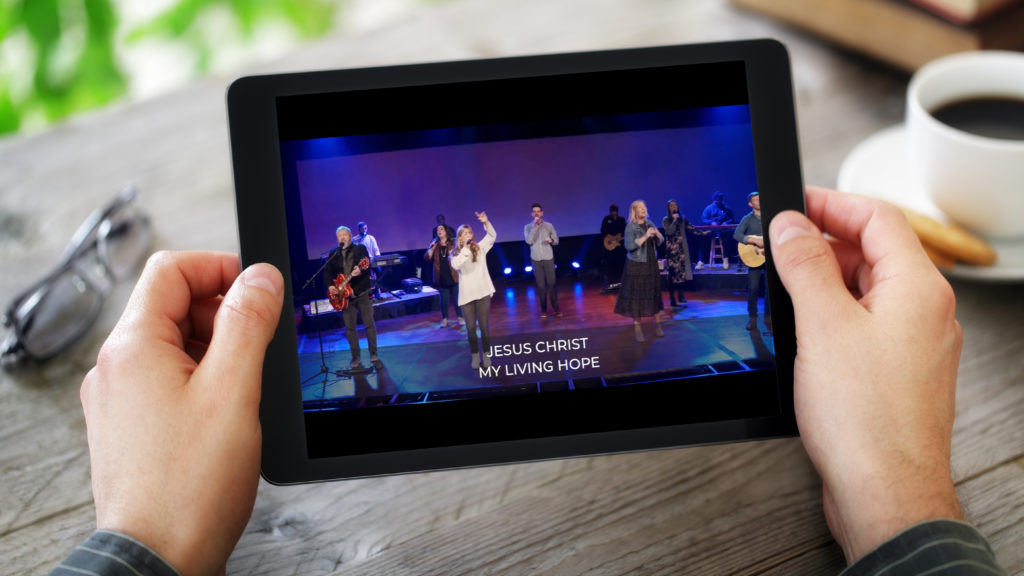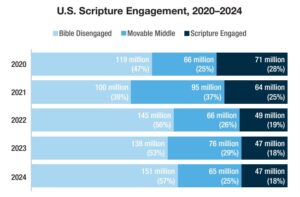
The first time a visitor walks into your church building, they probably know more about your church than you think. More than that, visitors may have even participated in a worship service already.
Much has been written about church websites being an unexpected “front door” to the church, but in the aftermath of the pandemic and near-universal adoption of video technology by churches, your online worship service is probably your new front door. For many, the first time they encounter your congregation will be through a video.
Churches should plan for this as they were quick to adapt to streaming services during the pandemic, reaching new and previous attendees through their online videos. Now, they’re trying to navigate how to transition people from this new front door online through their physical front door in person.
Quickly building a new door
In the fall of 2019, prior to the outbreak of COVID-19, Lifeway Research found 41 percent of Protestant churchesweren’t putting any portion of their worship services online for people to view. By the end of March 2020, within a month of the pandemic, more than 9 in 10 churches provided some type of online video service. Online video options continued throughout the pandemic.
Still, pastors are hoping the 1 in 4 pre-pandemic churchgoers not currently attending services, some of whom may be watching online, will return. Three in 5 pastors (60 percent) say they’re specifically exhorting online worshippers, who are able, to trade their couch for a pew and attend services in person.
Yet, despite this desire, churches have continued digital services. In February 2022, 94 percent of churches were still posting video worship services online, with 84 percent live streaming those services and 10 percent posting sermons later, according to Lifeway Research.
Why? Perhaps because churches have seen tangible benefits of their videos, including ministering to underserved church members, reaching new people online and even adding fresh faces to in-person worship services.
Welcoming people in the new door
Some churches have experienced increased connections to their shut-ins, often older members who have physical ailments that prevent them from physically attending. Many were active in services for years but were forced away because of their declining health. The addition of online videos has enabled them to stay connected and participate with their congregations in at least a partial way.
Online services have also reached some non-churchgoers. Among those who say they don’t regularly attend church services, more than 1 in 4 (26 percent) participated in an online church service during the pandemic, according to a September 2021 Lifeway Research study. Meaning, unchurched individuals were exposed to worship services for the first time through videos posted online – some of whom may now be showing up in person.
As of early 2022, almost 3 in 4 pastors (74 percent) say their church has reached new people online in the past six months. Even more pastors (83 percent) say new people have recently attended or connected in person.
6 ideas to move people through the traditional door
For those trying to transition people from online to in person, the looming question is how. How can we motivate those who could physically attend to join us? How can we use the new front door to get people to actually step inside our church building?
1. Keep streaming
It may seem paradoxical to keep doing the very thing some are using instead of attending in person, but many are being reached through the video services who may be on the cusp of joining your church physically.
Treat the online worship service as a thread of connection with those viewers. You shouldn’t be looking to sever the thin line, but rather, turn it into a rope that can make the ties thicker.
2. Start creating
What if, instead of ending your worship service live streams, you added additional content to strengthen the connection with digital participants?
Start a podcast to add depth or application to the sermon. Launch a video book club or Bible study. Post FAQ videos on your website (or just create and use a free YouTube or Facebook account for your church). Make quick TikTok devotional videos. Record and share videos about your hobbies and interests – sports, gardening, cooking, hunting, video games, etc. – and weave in references to your faith and your church. Try something.
3. Keep exhorting
As you continue streaming your services and starting new channels, continue calling those who are able to join you in person. One of the reasons you keep streaming is because that’s the one clear avenue through which you can speak to those online-only viewers.
Take opportunities during the service to invite those watching to join you next Sunday. Talk about the importance of the “one-another” commands in the Scripture and how we can’t obey them in isolation. Stress the need of every follower of Jesus to walk together with others.
4. Leverage opportunities
Some online churchgoers have gotten in the habit of being viewers of and not participants in your worship services. It may take something different and unique to pull them up off their couches and out of their Sunday morning pajamas.
With warm weather arriving, plan for a churchwide picnic or other outdoor event that may feel safer for some who are hesitant to come to an indoor service. Talk about Easter as a time when everyone in the church can come together in person to worship our risen Savior. Look at potential events you can host or use to make a physical connection with digital viewers.
5. Be gracious
As some make the transition to in-person attending, take the opportunity to welcome them, not shame them. The goal is to integrate them into your church body. That’s more likely to happen if they feel well-loved and like welcomed members of the family and not embarrassing distant relatives.
Don’t single out those who are new or back for the first time in years with an awkward greeting from the stage. But make sure your congregation knows to intentionally seek out those individuals and make them feel at home.
6. Strengthen the connections
As they move into the rows of the worship service, help them eventually move into the circles of a small group. Speak about the need for group discipleship from the pulpit. Introduce small group leaders during the service. Make it a seamless transition for someone to move from watching online to attending in person to being involved in a small group.
As people are introduced to your church through the new front door of video, continue keeping the old front door open to digital-first guests and all those whom God draws to your congregation.















